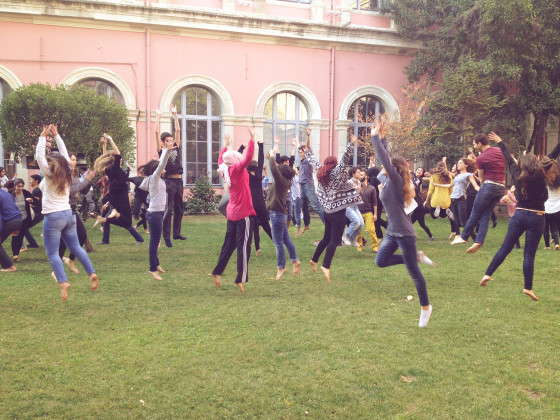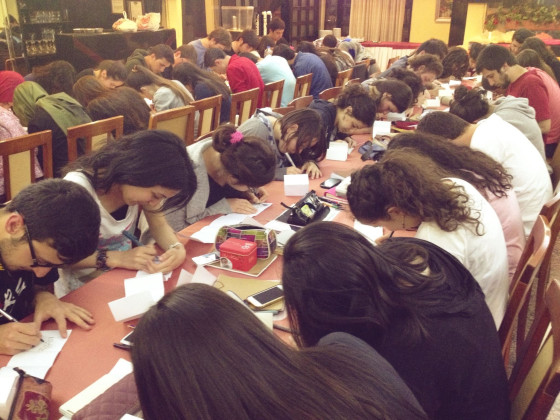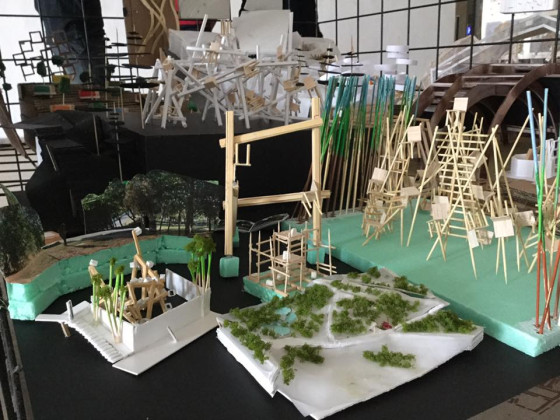“How to…. architectural education” or 10 Tips For A Successful Architectural Design Studio
In the last years, I have received a number of phone calls and emails related to the first year architectural education in ITU (Istanbul Technical University), which I have contributed in executing with different groups in the last 10 years. After a little introduction of themselves, people request whether I can send them any material; the curriculum, briefs, feuilles or program, because they are currently working on the development of a new architectural program and would like to make use of them for their first year architectural design studio.
My initial response was to make a list of “10 tips for a successful design studio” that, in the spirit of the day, would follow the tradition of 10 volume treatises of Vitruvius or Alberti (somehow there’s always a number of 10), only with a good amount of sarcasm, fun and irony.
Flattered as much as confused, I found myself in a moral dilemma that led me to a series of questions: Has architectural education become such a know-how package that is transmitted through such documents only? Was there a genuine expectation of a singular formula that is common to various groups I worked with (which all had peculiarities, distinct dynamics and conditions)? If such a commodity existed (made of accumulations of learnings, inheritances as well as countless trials, experimentation and variations with individual and collective efforts) could this be extracted from personal and peculiar deliberations or performance? Certainly, precedents have always been fundamental tools for learning. Although my practice within various groups was mostly based on experiments and inquires without a clue on final outcomes, just as much of it was the reinterpretation of the knowledge we inherited from the preceding studio culture, worldwide architectural programs we followed, or even found ideas in common sense. Most probably those who made the requests were also acquiring such information from several sources, to critically compare, analyze and develop into their own peculiar studio program.
Yet still, the situation remains problematic on several dimensions; architectural design studio being conceived as an instructive procedure that can be transcribed and conveyed through a series of documents (briefs, program etc.) for the process to be deliberately applied and controlled. The learning experience in design studio is diminished into a checklist of things to be done (with the student’s final outcomes as a key for control). Independent from the idiosyncrasies of the tutor’s position, performance, group dynamics, conditions or context, it is as if you follow the calendar, apply the series of instructions and work through tested design topics and tools, there would be a universally accepted standard to be reached.
The almost industrial scale of architectural education in Turkey (122 architectural programs in 20131), has made teaching into a popular practice for many architectural graduates who’d like to take a refuge from the constrains of the architectural market. However, although “teaching” in design studio is taken as an automatic capability for any architecture graduate, once it is approached from within, the complications that are otherwise covert start to reveal. Even for those who get into teaching through an academic position (even if they have been publishing extensive academic work until then) design studio remains an ambiguously open field which one needs to figure out how to develop personal and collective means, tools, positions, contents to act, think, develop and communicate an intended design-learning agenda in a particular pedagogical situation.
While the inherent difficulties of architectural design studio are enough to explain the urge to cling onto know-how packages, it is not the only one. Absence of a dominant discourse in contemporary architecture renders it exceedingly difficult to anchor, judge and take position accordingly. Additionally, the analogy between industry and architectural education (with the exception of some practices every now and then) present another set of pressure; the expectancy to produce an economic good (either material or service), an extreme care for efficiency (saving time and resources to increase benefit), an urge to standardize (increased guidelines for higher control), focus on the outcomes (a lack of interest in the process, motivations, consequences in energy consumption, issues of ownership, fairness, ethics etc.). The receiving end of this service (customers/students) also quest for maximum benefit in the shortest time possible, and ready to pay the price for receiving approval from recognized brands.
In summary, all these conditions urge mainstream architectural education towards an overly prescribed and guided process, adjusted for higher efficiency and guaranteed results. Design work is set to produce answers to predetermined questions; in contexts where both the problem and its outcomes are well specified, in realms that are preferably quantifiable and controllable. Standardization and over rationalization become defining gadgets for the curriculum. Success is evaluated mostly via final images, without attending to the missed opportunities for hesitations, disagreements, daydreaming, chance encounters or failures.
This trend should not be mistaken as exclusive to newly founded architecture schools (instead they can be more inquisitive in their approaches). For example in Turkey, even some well-established institutions with a long history of experimental and pluralistic approach to architectural design studio have started to steer their wheels towards such an agenda. Dramatic changes in the curriculum were made not by prevalent questions that could transform and trigger architectural learning, but on rationales based on vaguely debated concepts, statistics, market demands, which are communicated via excel files, template programs, instructions and handouts. Courses were compartmentalized for a more accurate application of knowledge and rigorous controllability of the outcomes.
In the age of radical pragmatism and post-truth, it is possible to observe the rise of technical knowledge for its emphasis on efficiency and assured validity for all times and places. In architecture, the notion of “technicality” is quickly attributed to orthographic drawing or application projects. Yet Habermas2 proposes a broader yet simpler definition for a knowledge constitutive interest to be technical. If founded on these three things: a predetermined goal, resources and know how, anything, even coffee making can fall into the category of a technical action. Technical knowledge is linked with an interest in “controlling”, which differentiates from understanding and emancipating. Its basic learning mode is “training”, where knowledge is “applied”. To better explain the rise of technical knowledge, Veysi Kondu had given a vibrant example where he compared the cost of teaching how to fly an F-16 versus investing to develop understanding towards cultural differences or establishing an emancipated dialogue.
Once projected to the field of architectural education, it seems important to comprehend the role and the dangers of the above-defined “technicalisation” both in curriculum and pedagogy. Technical knowledge surely has its historical role in architecture, not to undermine deep-rooted ideas such as efficiency, practicality or even standards, as long as the process is taken with a chance to produce one’s own questions, critically explore, judge and inquire. On the other hand, when it is merely “applied” through pre-defined frameworks, even the socially conscientious and critically-loaded notions such as participatory design, collectivism, accessibility, sustainability, interdisciplinarity, etc. are at the risk of fading into mere technicalities.
As a personal advocate for copy-left, creative commons, open-knowledge etc., this trend of copy-pasting studio curriculum bothers me not solely on the problematic of authorship. It is rather the lack of acknowledgement of the thin line between democratization of knowledge and settling down for a singular, generic, technical formula for architectural education. I believe that neither the tutors or students stand in design studio can exist outside personal inquiries, judgment, ethical choices, idiosyncrasies, authorial decisions or responsibilities. Making of a curriculum (what to teach), with its hidden and explicit agendas, or pedagogy (how to teach) cannot escape being a political act whether it invents something unique or copies an existing example.
One could and should learn from precedents, read all published material available on studio culture, investigate student works, briefs, curriculums etc., if possible experience, observe, discuss, feel, think and question the specificities of as many pedagogic cases as possible. But without the required effort and attention, architecture and its education are at the risk of becoming not different from mass production in disguise of mesmerizing images achieved by cutting-edge technologies.
A final remark would be to reveal the secret agenda of this text: to provoke anyone who is involved in architectural education to speak out. It is an invitation to those who’d like to share their experiences, motivations or dilemmas on educational practices in architecture schools, open into discussion some critical issues in Turkey and in the world, not only (and most popularly) through design studio, but through the culture of architectural education in its totality; with its explicit and hidden agendas, clichés, rituals, conventions and edges. It is an open invitation to contribute into a debate on architectural education that seems to be vital for the future role of architectural knowledge and practice in society.
Notes:
1 http://www.mimarlikdergisi.com/index.cfm?sayfa=mimarlik&DergiSayi=395&RecID=3573
2 Thanks to Veysi Kondu for his well rounded and inspiring lecture on Habermas’ categories of knowledge constitutive interests in ITU, November 2016.
Related Content:
-
Design Education in the Age of Artificial Intelligence
Bilge Bal and Bahar Avanoğlu talked with Mario Carpo on the first year design studios as the foundation of architectural education and the role of computational design tools in the field.
-
Handmade Inspirations
The world agenda full of crises makes it necessary for architectural practice to take a new look at the built and natural environment, and to develop new perspectives
-
Tactical Spatial Experiments in the Studio
Going up against the present “strategies” of architecture that feed on the cooperation between property, global capital and power, Asiye Akgün Gültekin and Erdem Üngür are searching for “tactics” through which architecture may seek the absence of space and power. The following text explores how they deal with the process in the architecture studio
-
Is Creativity the Goal?
Architecture is a beautiful art, an art of creating spaces; it produces new works of art
 03.08.2017
03.08.2017












